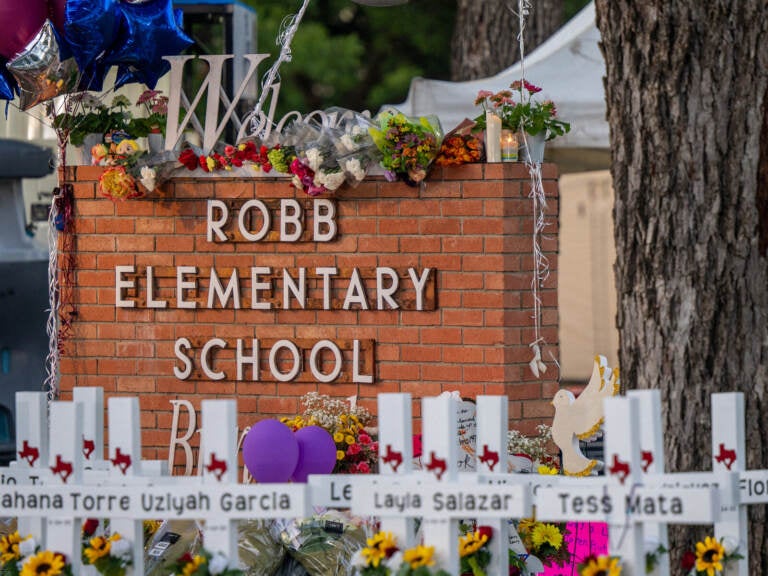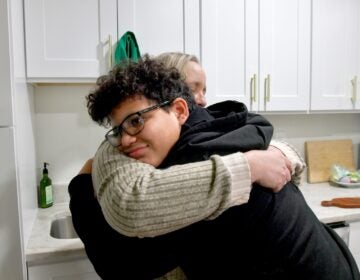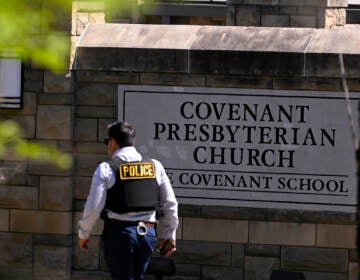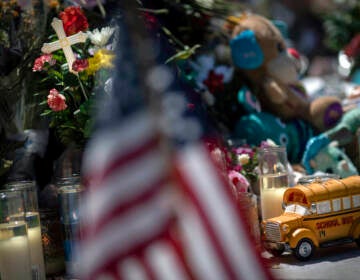The U.S is uniquely terrible at protecting children from gun violence

A memorial is seen surrounding the Robb Elementary School sign following the mass shooting at Robb Elementary School on May 26, 2022 in Uvalde, Texas. According to reports, 19 students and 2 adults were killed, with the gunman fatally shot by law enforcement. (Brandon Bell/Getty Images)
This week’s massacre in Uvalde, Texas, was yet another grim reminder that in the U.S., where civilians own nearly 400 million firearms, children are more likely to die from gun violence than in any other high-income country.
The killing of 19 fourth-graders and two adults at Robb Elementary School has unleashed an outpouring of grief and sadness across the nation. It has also, once again, spurred many to ask why the United States has failed to make any significant changes to its gun laws following the horrendous mass shootings that now happen with regularity.
Columbine High School, Virginia Tech, Sandy Hook Elementary, Marjory Stoneman Douglas High School: All are names seared into the nation’s memory for the terrible violence that took the lives of students there.
But the dangers young people face from firearms in America go well beyond school shootings, which account for only a fraction of all gun-related deaths. Whether it’s the gun violence they face in their neighborhoods, or suicide or accidents at home when guns are left unsecured, the threat to the nation’s children and teenagers is not only bad, but worsening.
“It’s extremely scary,” says Ade Osadolor-Hernandez, 20, a rising junior at the University of Chicago and a member of the national advisory board for the group Students Demand Action. “It’s extremely disappointing to see that we’re still living in this condition, and that there is nothing that is being done to save our lives.”
Guns are now the leading cause of death among young people in the U.S.
For decades, car crashes were the leading cause of death for Americans ages 1 to 19. But the gap between car crash deaths and firearms deaths began to steadily narrow in recent years. In 2020, gun violence overtook car accidents to become the No. 1 cause of death for U.S. children and adolescents.
Researchers at the University of Michigan found that while firearm-related deaths overall increased 13.5% between 2019 and 2020, among children and adolescents they surged a staggering 30%.
In the U.S., kids are more likely to die from gun violence than in other wealthy countries
For years, researchers at the University of San Francisco and Harvard T.H. Chan School of Public Health have compared the rates of firearm deaths in the U.S. and other populous, high-income countries — mostly nations in Europe.
Their most recent study, which looks at data from 2015, finds that the U.S. accounts for the vast majority of firearm deaths among children. Across the 29 countries in the study, the U.S. accounted for almost 97% of the firearm deaths among children 4 years old or younger, and 92% of firearm deaths for those between the ages of 5 and 14.
And over time, the U.S. is accounting for an ever-larger share of people killed by guns in these countries. The U.S. firearm death rate increased nearly 10% between 2003 and 2015, even as it fell in other high-income countries.
Compared to countries of all sizes and incomes, the firearm-related death rate in the U.S. ranks 32nd in the world, according to a study by the University of Washington’s Institute for Health Metrics and Evaluation. (Topping that list, which uses data from 2019, were El Salvador, Venezuela and Guatemala.) When the total number of firearm deaths are counted, the U.S. ranks second in the world, after only Brazil, according to a study using data from 2016.
One factor in America’s high level of gun deaths is the massive number of guns in the country: Civilians in the U.S. own an estimated 393 million firearms, according to a 2018 study by the Small Arms Survey. That’s nearly 46% of the estimated 857 million civilian-held firearms in the world. That’s a striking proportion, when the U.S. has just 4% of the world’s population.
The numbers of gun-related deaths and injuries are climbing
Five years ago, just under 4,000 children and teens up to the age of 17 were killed or injured by gun violence, according to the Gun Violence Archive. By the end of last year, that number was up 43% to 5,692. Some 1,560 of these children and teenagers died.
So far in 2022, at least 653 children and teens in the U.S. have been killed by guns. Another 1,609 children and teens have been injured by firearms, according to the archive.
The highest rates for gun-related deaths, according to an analysis by the National Safety Council, are among people ages 15 to 34.
Many guns come from inside the home
In 2012, the shooter at Sandy Hook used his mother’s guns to kill her and 26 children and school staff members. In the 2018 shooting at Santa Fe High School in Texas, the shooter used his father’s guns.
Research published last year and funded by the National Institute of Justice (a program of the U.S. Justice Department) suggests that’s very much the norm. The analysis examined mass shootings that took place from 1966 to 2019 and found that over 80% of mass shooters at K-12 schools stole guns from family members.
“The findings support safe storage of guns,” the authors write. But as the analysis points out, “there are no federal laws requiring safe storage of guns, and no federal standards for firearm locks.” The NIJ said the data “also support ‘red flag’ laws permitting law enforcement or family members to petition a state court to order temporary removal of a firearm from a person who presents a danger.”
Most people killed by gun violence don’t die in mass shootings
The Uvalde massacre was the 27th school shooting in the country this year.
Though mass shootings tend to get the most attention, they are not the cause of most firearm deaths in the U.S.
In 2020, 45,222 people died from gun-related injuries, according to the Centers for Disease Control and Prevention — about 124 people each day. Of those, 54% were suicides, and 43% were murders, according to a Pew Research Center analysis. Other firearm-related deaths were unintentional, involved law enforcement or had undetermined circumstances, according to Pew.
That same year, 513 people died in mass shootings, according to the Gun Violence Archive — meaning mass shootings accounted for about 1% of all gun deaths in 2020. The archive defines a mass shooting as one in which four or more victims were shot, whether they were injured or killed.
According to the Brady Campaign to End Gun Violence, nearly 8,000 children and teens on average were shot and more than 1,600 died each year between 2015 and 2019. Of those who died, 52% were murdered, 40% died from gun suicide and 5% were killed unintentionally.
Youth suicide using guns is rising
An analysis by The Trace, a newsroom focused on gun violence, found a sharp rise in firearm suicide rates among young people in their teens and 20s in the U.S. between 2011 and 2020.
“The firearm suicide rate more than doubled among Black, Latino, and Asian teenagers, while it increased by 88 percent for Native Americans and 35 percent for white teens,” the analysis found.
A study published last year looked at 134 cases of suicide among children between the ages of 5 and 11 in the U.S. between 2013 and 2017. Researchers found that guns were the second most common method of suicide. When guns were used, in every case where details were available, “the child obtained a firearm stored unsafely in the home,” according to the analysis.
Young people are calling for action
“Every single time I walk into a classroom, the first thing I do is find the nearest exit,” says Osadolor-Hernandez, the UChicago student and anti-gun violence advocate.
Instead of being focused on her professor’s lecture, she finds herself constantly glancing around to see if anyone looks suspicious.
“Every single time anyone just reaches into their backpack, there is a sense of panic that I feel,” she says. “It’s extremely frustrating to have to feel this way, and it’s extremely hard to live with this reality.”
She says many people seem to have growing concern for the problem. Now she wants to see the same from lawmakers: “We are demanding action from them and it is time for them to listen to us, and to truly, truly change the way that this country is functioning.”
Osadolor-Hernandez says she sees the harrowing numbers and fears for future generations.
“I even wonder if I want to have kids when I’m older,” she says, “because do I want to put my kids in the situation where they might be shot and I won’t be able to live with them again? It’s a real fear that I live with every single day of my life.”
If you or someone you know may be considering suicide, contact the National Suicide Prevention Lifeline at 1-800-273-8255 (en español: 1-888-628-9454; deaf and hard of hearing: 1-800-799-4889) or the Crisis Text Line by texting HOME to 741741.




